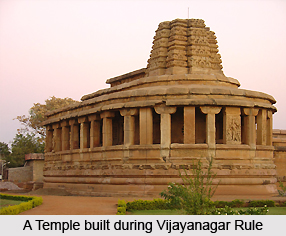 Viranarasimha Raya, also referred as Vira Narasimha III or Vira Narasimha ruled the kingdom of Vijayanagar from the year 1505 to 1509. He was the younger brother of Krishna Deva Raya and became the king after the demise of the king Tuluva Narasa Nayaka.
Viranarasimha Raya, also referred as Vira Narasimha III or Vira Narasimha ruled the kingdom of Vijayanagar from the year 1505 to 1509. He was the younger brother of Krishna Deva Raya and became the king after the demise of the king Tuluva Narasa Nayaka.
Tuluva Nayaka`s death sparked revolts led by feudatories in the Vijayanagara Empire. Immediately after the death of Tulava Nayaka, Immadi Narasa Nayaka ascended the throne and his regime continued for a period of two years, till he was murdered. During 1505, Vira Narasimha Rao assumed the throne, though a majority of his reign was marked with constant conquests and fighting battles against rebellious warlords.
The ruler of the then Bijapur region, Yusuf Adil Khan made an attempt to expand his territories till the southern limits of the area of Tungabhadra. However, Adil Khan lost the battle against Aliya Rama Raya, the regent of Vijayanagara Empire. The army of Vijayanagara also consisted of Thimma, the son of Aliya Rama Raya, who belonged to the Aravidu family. Thereafter, the areas of Kurnool and Adani were annexed by Vijayanagara. Around this point of time, the chief of the region of Ummattur revolted and Vira Narasimga Raya marched towards southern part of India to suppress this rebellion. Krishna Deva Raya was placed at the throne of Vijayanagara in his absence. Vira Narasimha Raya was assisted by Portugal in this political conflict against the chief of Ummattur. Artillery and a vast quantity of horses were supplied by Portugal to Narasimha Raya. In exchange for Portugal`s cooperation, Vira Narasimha Raya had to permit the Portuguese army to gain control over the port of Bhatkal.
According to a legend, in the year 1509, when Vira Narasimha Raya was on his deathbed, he had requested Saluva Thimma or Thimmarasa, his minister to have his younger brother Krishna Deva Raya blinded since he wished his own eight-year-old son to succeed him to the royal throne. However, instead of blinding Krishna Deva Raya, the minister had displayed a pair of eyes of a she-goat to Vira Narasimha Raya and told him he had assassinated Krishna Deva Raya. Historical records however contain no such references and have maintained that a cordial relationship was existent between the two brothers and the coronation of Krishna Deva Raya occurred without any conflicts or complications.






































